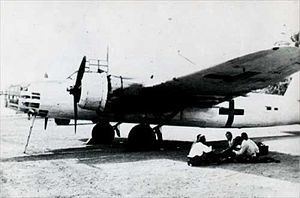Top speed 492 km/h Length 16 m | Wingspan 20 m First flight August 1939 | |
 | ||
The Nakajima Ki-49 Donryu (中島 キ-49 呑龍) "Storm Dragon" was a twin-engine Japanese bomber aircraft of World War II. Despite its official designation as Army Type 100 Heavy Bomber, the requirements of the Ki-49 – to operate unescorted, with heavy defensive armament and armor – restricted it to a small bomb load (initially 1,000 kg (2,200 lb).
Contents
- Revell 1 72 nakajima ki 49 donryu helen kit h 102 600
- Development
- Operational history
- Variants
- Wartime
- Post war
- Specifications Ki 49 IIa
- References

A mid-wing, cantilever monoplane of all-metal construction, the Ki-49 was one of the first Japanese aircraft fitted with a retractable tailwheel. During World War II, it was known to the Allies by the reporting name "Helen".

Revell 1 72 nakajima ki 49 donryu helen kit h 102 600
Development
The Ki-49 was designed to replace the Mitsubishi Ki-21, which entered service in the Imperial Japanese Army Air Force in 1938. Learning from service trials of the Ki-21, the Army realized that however advanced it may have been at the time of its introduction, its new Mitsubishi bomber would in due course be unable to operate without fighter escorts. As a result, the Japanese Army stipulated that its replacement should have the speed and defensive weaponry to enable it to operate independently.
The prototype first flew in August 1939 and the development programme continued through three prototypes and seven pre-production aircraft. This first prototype was powered by a pair of 708 kW (950 hp) Nakajima Ha-5 KA-I radial engines, but the next two had the 932 kW (1,250 hp) Nakajima Ha-41 engines that were intended for the production version. Seven more prototypes were built, and these completed the test programme for the aircraft. Eventually in March 1941, the Donryu went into production as the Army Type 100 Heavy Bomber Model 1.
Operational history
Going operational from autumn 1941, the Ki-49 first saw service in China. After the outbreak of the Pacific War it was also active in the New Guinea area and in raids on Australia. Like the prototype, these early versions were armed with five 7.7 mm (0.303 in) machine guns and one 20 mm cannon. Combat experience in China and New Guinea showed the Donryu to be underpowered, with bomb capacity and speed suffering as a result. Thus, in the spring of 1942 an up-engined version was produced, fitted with more powerful Ha-109 engines, and this became the production Army Type 100 Heavy Bomber Model 2 or Ki-49-IIa. The Model 2 also introduced improved armor and self-sealing fuel tanks and was followed by the Ki-49-IIb in which 12.7mm (0.5 in) Ho-103 machine guns replaced three of the 7.7 mm (0.303 in) Type 89 machine guns.
In spite of these improvements however, losses continued to mount as the quantity and quality of fighter opposition rose. An attempt was made to stop the rot in early 1943 by further up-engining the type. This petered out, however, owing to development difficulties with the 1,805 kW (2,420 hp) Nakajima Ha-117 engines and the Ki-49-III never entered production with only six prototypes ever being built.
In the face of its increasing vulnerability to opposing fighter aircraft while performing its intended role, the Ki-49 was used in other roles towards the end of the Pacific War, including ASW patrol, troop transport and, ultimately, as kamikaze.
After 819 aircraft had been completed, production ended in December 1944.
Variants
Wartime
Post-war
Specifications (Ki-49-IIa)
Data from Axis Aircraft of World War II; Japanese Aircraft of the Pacific War
General characteristics
Performance
Armament
